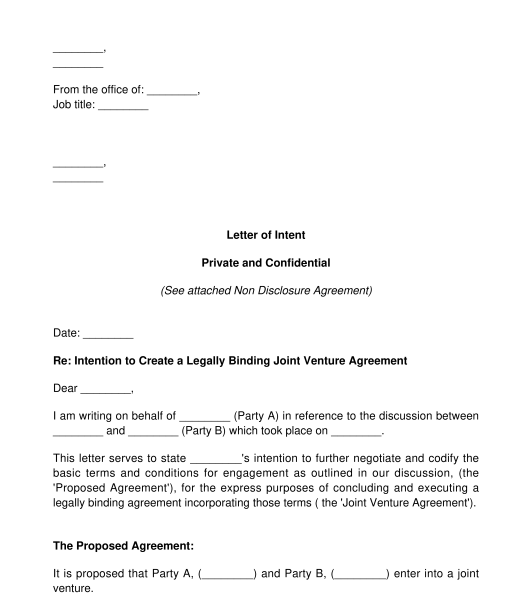 04/09/2025
04/09/2025

Answer a few questions and your document is created automatically.

Your document is ready! You will receive it in Word and PDF formats. You will be able to modify it.

 04/09/2025
04/09/2025
 Word and PDF
Word and PDF
 6 to 8 pages
6 to 8 pages
A Letter of Intent asserts a party's interest in participating in a proposed transaction or agreement with another party.
It is used to signal that the Party sending the letter is serious about entering into a legal relationship, even though the precise terms and conditions of that relationship are not yet clear or still under negotiation.
A Letter of Intent is useful in manner respects. It identifies the Party sending the letter's objectives and intention in regards to the proposed transaction or arrangement. The Party sending the Letter of Intent can clearly articulate what they want from the deal, a proposed timeline for completion and how the two Parties ought proceed. This focuses negotiations without getting bogged down in the finer details. Moreover, because a Letter of Intent is pitched a broad, general level, it communicates the Party's willingness to compromise and negotiate with a view to concluding a contract. A Letter of Intent expresses the Party's sincerity and good faith in progressing with negotiations which supports relations between the Parties and can expedite negotiations.
While expressing an intention to enter into a proposed agreement and legal relations, this document is not legally binding. It is not a contract and not enforceable. It is a meaningful step in progressing relations to the point where an effective legally binding agreement can be concluded.
This document contains important information that helps facilitate relations between the Parties. It sets out the Party sending the letter's contact information, and if the Party is a legal entity, identifies individual(s) within the organisation as points of contact. It outlines the Party's understanding of the potential deal on the table, 'the Proposed Agreement' and the respective roles of the Parties thereunder. A timeline for completion is included, a 'closing date' by which the Party would ideally like a legally binding contract. The information included is not fixed in stone, but remains subject to ongoing negotiation, the document makes this fact clear.
It is common for a Letter of Intent to be accompanied by a Non Disclosure Agreement. This ensures that proprietary information exchanged by the Parties during deliberations will remain confidential and not be disclosed to third parties, irrespective of the outcome of any negotiations. If in the course of deliberations, either Party will reveal proprietary or sensitive information, the unauthorised disclosure of which could imperil their competitive advantage, it is advised that a Non Disclosure Agreement be adopted in tandem with the present document.
How to Use this Document:
This document can be used at the start of negotiations, at advanced stages of negotiations, or anytime in between. It can be used by businesses, individuals, independent contractors or any agent seeking to express their intention to pursue a proposed agreement.
This document is designed to deal with a wide range of potential transactions or agreements. The user should indicate whether the Letter of Intent is being written in respect of a transaction or agreement.
This document should be used when many details are yet to be decided, but the author has a clear understanding of their wider expectations and objectives in the prospective business arrangement or transaction and a reasonable timeline for negotiations can be conceived.
The Party sending the letter should articulate their goals and interests in a way that reflects the current status of negotiations, and the nature of the transaction being discussed.
There are many situations in which the present document can be employed.
The document specifically caters for the following proposed agreements:
and the following proposed transactions:
This notwithstanding, this Letter of Intent can be employed for any proposed transaction or agreement not mentioned here. When choose among the list of options, the user need only select 'other' and a basic template will appear on the document. This will still contain all core details necessary for a Letter of Intent, but excludes extra information specific to the above categories of agreement.
The Party sending the letter should sign and send the document as soon as possible, especially as the information included may be time sensitive. The document may then be signed and returned by the other Party to the proposed agreement or transaction. The document can then serve as a touchstone for ongoing and future negotiations.
Governing Law
This document is governed by the principles of Contract Law.
How to modify the template:
You fill out a form. The document is created before your eyes as you respond to the questions.
At the end, you receive it in Word and PDF formats. You can modify it and reuse it.
Letter of Intent - sample template - Word and PDF
Country: Ireland